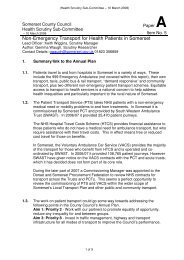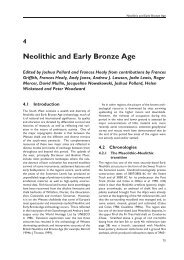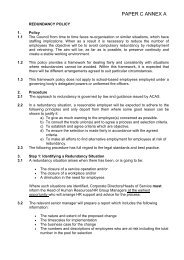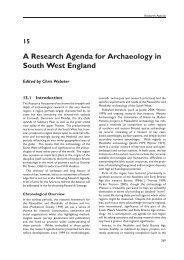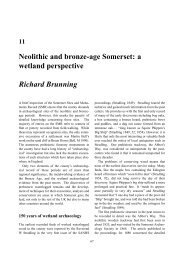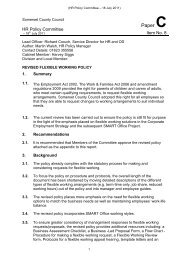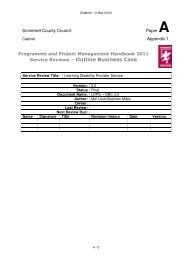In Year School Admissions - Somerset County Council
In Year School Admissions - Somerset County Council
In Year School Admissions - Somerset County Council
Create successful ePaper yourself
Turn your PDF publications into a flip-book with our unique Google optimized e-Paper software.
(Cabinet Member Decision – 4 January 2012)SOMERSET COUNTY COUNCILTHE CABINETCABINET MEMBER NON-KEY DECISIONReport title: <strong>School</strong> Admission - <strong>In</strong> <strong>Year</strong> arrangementsCabinet Member(s): Mr J Osman, Cabinet Member-Children & Young PeopleOfficer Contact Details: Julia Ridge email: jaridge@somerset.gov.uktel.: 01823 357633Date of Decision: 4 January 2012Date of Publication of decision: 4 January 2012Date decision comes into force: 10 January 20121. Cabinet Member DecisionFollowing consideration of the officer report and the equalities impactassessment, the Cabinet Member-Children and Young People agreed that fromthe 1 st January 2012 schools are able to give parents application forms and oncea place has been allocated, send an acceptance letter on behalf of the LocalAuthority in accordance with the process set out in Appendix A.2. Reason for Decision(s)As set out in the attached report.3. Reason(s) for Urgency (where applicable)Not applicable.4. Any relevant Personal <strong>In</strong>terest that the Cabinet Member may have underthe <strong>Council</strong>’s Code of Conduct for membersMember of Mendip District <strong>Council</strong>.5. Other background information considered by the Cabinet Member beforemaking this decisionAs set out in the attached report.1 of 12
(Cabinet Member Decision – 4 January 2012)Officer Report– 04 January 2012<strong>School</strong> Admission - <strong>In</strong> <strong>Year</strong> arrangementsCabinet Member: Mr J OsmanDivision and Local Member: AllLead Officer: Julia Ridge, Group Manager, Strategic Planning, CYPDAuthor: Julia Ridge, Group Manager, Strategic PlanningContact Details: Tel: 01823 357633 email: Jaridge@somerset.gov.ukPlease complete sign off boxes below prior to submission to Community GovernanceSeen by: Name DateLegalHonor Clark28 December2011Report Sign off21 DecemberSenior Manager John Kirby2011Cabinet Member Mr J Osman21 December2011This paper explains proposals to alter the administrativeprocedure relating to in-year admissions. These changes willenable schools to engage more directly with families seekingSummary:school places during the academic year whilst enabling theAuthority to manage its statutory duty of co-ordinating in-yearadmissions.Recommendations:Reasons forRecommendations:Links to Prioritiesand Impact onService Plans:FinancialImplications:EqualitiesImplications:It is recommended that from the 1 st January 2012 schoolsare able to give parents application forms and once a placehas been allocated, send an acceptance letter on behalf ofthe Local Authority in accordance with the process set outin Appendix A.<strong>Somerset</strong> schools have requested that the current system ischanged as the head teachers feel it is important to buildrelationships with parents from an early stage.• <strong>In</strong>vest in new schools, ensuring high quality school places andthe improved condition of school facilities;• Actively support increased educational attainment,achievement and improved outcomes;Currently forms are sent out by <strong>Somerset</strong> Direct and the lettersare sent by the Authority. Although this work is very quick andsimple, due to the volume we estimate that there should be asaving of £5,000 per year. <strong>Admissions</strong> are funded from theschools budget.The new process will enable pupils to attend schools morequickly when they move into an area. This is thereforebeneficial. The Authority records and monitors the number ofchildren who move schools in-year and has the following data:Free school meals, SEN and English as a second language.If it appears that the process is adversely affecting any of thesegroups the Authority, through the escalation procedure and themeetings with the head teacher, will intervene.2 of 12
(Cabinet Member Decision – 4 January 2012)The Authority remains statutorily responsible for in-yearadmissions and therefore the Authority must ensure that schoolsact in accordance with the agreements. To ensure this happensthe schools, through the ‘Compact’ have agreed to an escalationprocedure which will improve systems in schools where they donot meet the <strong>Admissions</strong> Code.Risk Assessment:ScrutinyRecommendation(if any):The Authority has less sight of parents who are moving pupils inyear which may lead to more children missing from education.To ensure that this does not happen, schools will keep a registerof all pupils that request an application form.Parents may not know their rights. To ensure that parents haveaccess to their rights the Authority will maintain its website anduse <strong>Somerset</strong> Direct to advise parents. <strong>Somerset</strong> <strong>County</strong><strong>Council</strong> will also send out the refusal letters outlining the appealsprocedure.N/A1. Background1.1. The current <strong>Admissions</strong> Code introduced central Local Authority co-ordination ofin-year admissions in September 2010, which moved the administration of inyearadmissions from <strong>Somerset</strong> schools to the Local Authority. Although this hasproved beneficial to the Local Authority in terms of tracking and monitoring pupilmovement, especially vulnerable children, it did also remove an important linkbetween schools and parents. These proposals seek to re-establish this link.2. Options Considered2.1. Until September 2013 in-year admissions remain the responsibility of the localauthority, however head teachers have asked through the Compact if theprocess could be changed to allow schools to play a greater role in the in-yearadmissions process. As a local authority we can see the advantages ofdelegating parts of the process to governing bodies as it will strengthen therelationship between schools and parents.2.2. The <strong>Admissions</strong> Code is statutory guidance on the local authority and therefore ifgoverning bodies accept the additional delegation there must be simple recordsheld within the school which the authority can check to make sure that theprocesses followed within the school are as agreed and in line with the Code ofPractice.<strong>In</strong> order to help governors ensure that the admissions process is being followedcorrectly, if the authority becomes aware of any concerns about admissionpractices at a particular school then, in the first instance, we will write to headteachers and copy to the Chair of Governors. This will enable schools to takeaction to ensure the code is met.2.3. The process for <strong>In</strong> <strong>Year</strong> <strong>Admissions</strong> is set out in Appendix A and in principle,3 of 12
(Cabinet Member Decision – 4 January 2012)allows for schools and academies to:1. Give parents an application form rather than asking parents to contact<strong>Somerset</strong> Direct.2. To ensure the authority does not risk losing children from the educationsystem by, keeping a register of all requests for application forms.Write to parents confirming they have a place at the school using a LocalAuthority template or inform the local authority that a place is not available. <strong>In</strong> thecase of refusal the local authority will send out the refusal letter.2.4. The local authority will remain responsible for:1. Receiving the application.2. Checking whether places are available at schools and asking schools whoare their own admissions authority whether places are available withintheir admissions policy.3. Ensure the <strong>Admissions</strong> Code is being adhered to4. <strong>In</strong>forming chairs of governors if the <strong>Admissions</strong> Code is not being followedat their school or academy.The requirement for schools and academies to only offer or refuse places withinthe context of their published admission policy remains.3. Consultations undertaken3.1. The request for more school involvement was made by the leadership group ofthe Compact at their meeting on 29 September 2011. Proposals were taken tothe Compact Executive on 19 October 2011and 22 November 2011 and agreed.The Compact Executive is attended by Early <strong>Year</strong>s providers, Primary,Secondary and Special schools representatives, alongside members and officersof <strong>Somerset</strong> <strong>County</strong> <strong>Council</strong>.4. Implications4.1. There are approximately 5900 in-year admissions each year. The ImpactAssessment is set out in Appendix B.5. Background papers5.1 Dept for Education website New <strong>Admissions</strong> Code:http://www.education.gov.uk/schools/adminandfinance/schooladmissions/a00199845/departmentalrespMinutes of Compact Executive meeting: 29 September 2011Minutes of Compact Executive meeting: 19 October 2011Minutes of Quality of Universal Provision/Sufficiency Leadership Group: 22 November 2011Note: For sight of individual background papers please contact the report author.4 of 12
(Cabinet Member Decision – 4 January 2012)Appendix A2012 <strong>In</strong> <strong>Year</strong> AdmissionPotential to delegate administration of in-year admissions to <strong>School</strong> GoverningBodies (ahead of September 2013 changes)Process<strong>School</strong>s to distribute standard inyear application form. <strong>Somerset</strong>Direct to advise parents to requestfrom schoolsAdvantageTo re- establish a closerrelationship between parents,students and schools.<strong>School</strong>s can gauge the level ofprospective applicants.Application form is returned to theLocal Authority.LA demonstrates that they areco-ordinating admissions andcan monitor. Co-ordinationwith Out of <strong>County</strong> Placementand other admissionsauthorities can continue.LA investigates preference withschoolsParental confidentiality ismaintained if the parent isinterested in more than oneschool.<strong>School</strong>(s) consider the applicationagainst admissions numbers andover subscriptions criteria.Advises LA where a placecan be made available ornot and whyNO – LA sends outstandard refusal letterand appeal instructionsLOCALAUTHORITYCO-ORDINATIONYES -LA notifies schoolto send out standardoffer letter<strong>School</strong> sends out standardletter to applicant on behalfof admissions authority5 of 12
Appendix BImpact Assessment Form and Action Table(Expand the boxes as appropriate, please see guidance to assist with completion)Why are you completing the Impact Assessment?Proposed New Policyor ServiceChange to Policy orServiceWhat are you completing the ImpactAssessment on (which policy, service, MTFPreference, cluster etc)?Section 1 – Description of what is being impact assessedMTFP or PaperService Review or SCCChange ProgrammeChange in the way the service is delivered for in yearadmissionsThe change from the Authority sending out application forms for schools, to parents being able torequest them from their local school.Section 2A – People or communities that are targeted or could be affected (for Equalities - takingparticular note of the Protected Characteristic listed in action table)All school aged pupils whose parents wish them to move in-year between schools approx5,900 per year in <strong>Somerset</strong>.Section 2B – People who are delivering the policy or serviceThe service is currently delivered by the admissions team in CYPD and <strong>Somerset</strong> Direct. <strong>In</strong>the future parents will be able to access the information locally via schools. <strong>In</strong> future formswill be offered to parents directly by schools and their staff.Section 3 – Evidence and data used for the assessment (Attach documents where appropriate)For all pupils who move schools during the year the authority will look at data on:Free school meals entitlement, special educational needs and English as a second language. Thisdata will be monitored by the authority and shared with schools on a regular basis.The data currently shows that there is a disproportionate number of pupils with English as a SecondLanguage moving into schools in the school year. This of course, is expected as they tend to bemoving to the town following their parents work.The Data also shows a disproportionately high number of children moving with Special EducationalNeeds. This may indicate that the parents’ perception is that an alternative school may better meettheir child’s needs.This process supports getting pupils into their new school more quickly which will be beneficial to theirlearning and the process itself is not anticipated to have any thing other than a positive impact.However, the data will be monitored to ensure this is the case.6 of 12
Appendix BSection 4 – Conclusions drawn about the impact of the proposed change or new service/policy(Please use prompt sheet for help with what to consider):Key issues to be fed into relevant Action Table<strong>School</strong>s are concerned that it takes a number of days for children moving to their community to be given aschool place and that children move schools within their community without due regard to their education.The new process is designed to help parents by giving them more contact with schools whilstrecognising absolutely the independence of the admissions process. The scheme has beendeveloped to enable schools to have a greater awareness of a child’s admission process so they arebest able to support children attending their school.The co-ordination of the process remains with the Local Authority to protect the rights of the child andparents.We anticipate that this process reduces the amount of in-year admissions within communities helpingyoung people develop skills to sort out issues rather than moving to a new school.EqualityThe data for free school meals, English as a foreign language and SEN will be monitored to ensurethose children have equal access to school places.Health and SafetyDeemed not to be relevant because Health and Safety is managed by the school.SustainabilityDeemed not to be relevant because the choice of school is not made on sustainability grounds.Community SafetyDeemed not to be relevant because the choice of school is not made on community safety grounds.PrivacyThe Authority remains responsible for holding the data about school choices to protect the parents'privacy over school preference.Business RiskThe Authority has agreed an escalation process to ensure that schools undertake this delegated workcorrectly for the Authority.Section 5 – After consideration please state your final recommendations based on the findings fromthe impact assessment. Also include any examples of good practice and positive steps taken.The Compact Executive asked if the process could be available from 31 October 2011. However, itwas proposed for 01 January 2012. Concern was expressed by Social Care that there may be anincrease in children missing from education, hence the requirement for schools to keep a record of allchildren requesting an application.a) Group Manager Recommended Decision:The process should be delegated to schools as it will improve the relationship between schools andparents and reduce the time it takes pupils to get school places when they move into an area.7 of 12
) Service Director / CYPD DMT Decision (6 January 2012):Appendix BSection 6 - How will the assessment, consultation and outcomes be published and communicated?E.g. reflected in final strategy, published. What steps are in place to review the Impact AssessmentThe information is published with the Compact. <strong>In</strong> addition the data on in-year admissions, so trends can beidentified, will be shared at a number of area meetings across the county twice per year.<strong>Somerset</strong> <strong>County</strong> <strong>Council</strong> website.Completed by:Julia RidgeDate 22 December 2011Signed off by:DateCompliance sign offDateTo be reviewed by: (officer name)Review date:John Kirby / CYPD DMTVersion 2 Date 14 December 20118 of 12
Identified issuedrawn from yourconclusionsAge<strong>Year</strong> 11 StudentsDisabilityPupils with specialeducational needs.Gender ReassignmentNo gender issuesidentifiedMarriage and Civil PartnershipActions needed –can you mitigate theimpacts? If you canhow will youmitigate theimpacts?Develop fair accesscodeDevelop fair accesscodeEquality Impact Assessment Issues and Action TableWho is responsiblefor the actions?None Julia RidgeWhen will the actionbe completed?How will it bemonitored?Appendix BWhat is theexpected outcomefrom the action?Nigel Shipton April 2012 Ensure year 11children have accessto education.Mike Turner April 2012 Children with SpecialEducational Needshave equal access toeducation andappropriate additionalsupport.Pregnancy and MaternityRace (including ethnicity or national origin, colour, nationality and Gypsies and Travellers)Pupils with English asa Second LanguageDevelop fair accesscodeNigel Shipton April 2012 Children with Englishas a SecondLanguage have equalaccess to educationand appropriate9 of 12
Religion and BeliefNo faith issuesidentifiedSexNone Julia RidgeAppendix Badditional support.Sexual OrientationNo sexual orientationissues identified.NoneOther (including caring responsibilities, rurality, low income, etc)Low incomeRuralityDevelop policies inline with pupilpremiumDevelop transportpoliciesJulia Ridge Sept 2012 Yes Free school mealsRural access withappropriate transport10 of 12
Areas of increasedrisk drawn fromyour conclusionsHealth and Safety, Sustainability, Community Safety Impact Assessment Issues and Action TableActions needed –can you mitigate theimpacts/risk? If youcan how will youmitigate theimpacts?Who is responsiblefor the actions?When will the actionbe completed?Health and Safety Issues and Action TableHow will it bemonitored?Appendix BWhat is theexpected outcomefrom the action?Sustainability Issues and Action TableCommunity Safety Issues and Action TablePrivacy Issues and Action TableBusiness Risk Issues and Action Table11 of 12
12 of 12Appendix B







